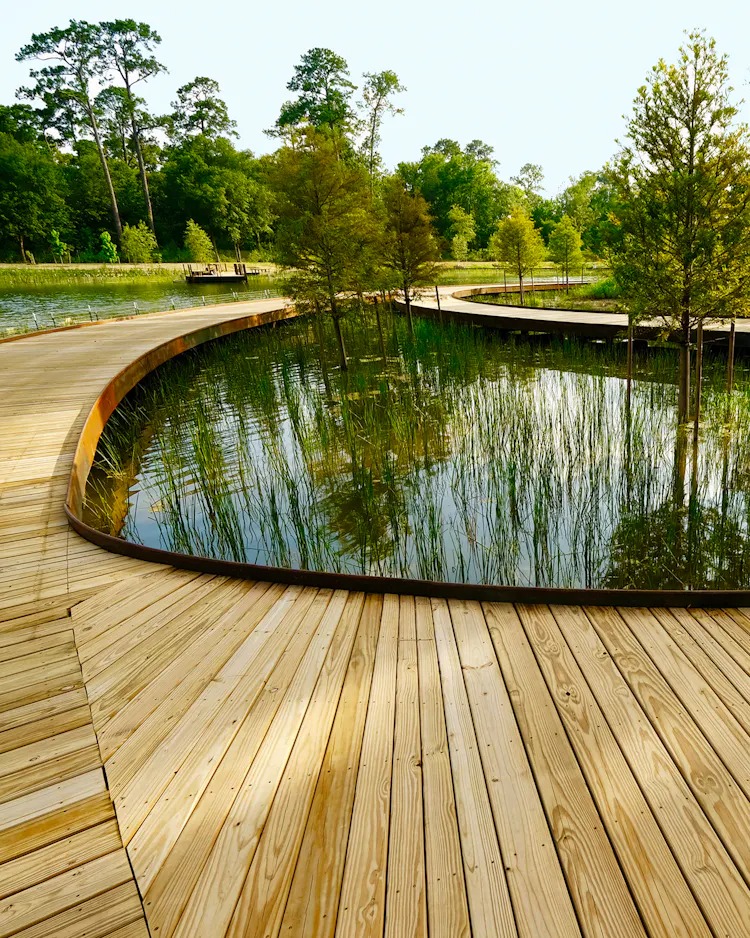
“Rich in history” doesn’t do this place justice. Describing Houston’s Memorial Park and its significance and popularity cannot be overstated. Over 100 years ago, Ima Hogg donated the original land and proclaimed what it was to remain. Ima Hogg, sister to the park’s benefactors, Will and Mike Hogg, declared the land “for park purposes only” and, if not, was to be returned. Houstonians have honored this pledge throughout the years, and now in a big way. Picnics, marriages, walks, runs, prayers, sightseeing, cycling, and golfing are just a few daily happenings this park has provided over the last 100 years for the hundreds of thousands of Houstonians and out-of-towners visiting the park each year.
According to sources, Texas and Houston experienced a deadly drought in 2011 that devastated the park and threatened or killed almost half the trees. Only three years earlier, in 2008, Hurricane Harvey provided a double whammy to the park’s ecosystem.
It was time for the park to undergo a major transformation, with Thomas Wolf Byrd Landscape Architects to the rescue rather than an initial idea of replanting back to its original dense forest.
In the early 1900s, the land was an orchard and also used for logging and brickmaking. Trees were cut down to build Camp Logan, a World War I training site infamous for a deadly uprising by black soldiers in 1917. At the war’s end, pines refilled the campsite, burying this history in the thicket of trees. According to Shellye Arnold, Memorial Park Conservancy president and CEO, efforts were made later to acknowledge the race riot incident. There’s a plaque commemorating the camp, with personal quotes from more than 50 Houstonians about what the park means to them.
Many of these trees did not survive the drought.
The response to this loud ecological wakeup call and the growing chorus of prominent Houston residents ultimately decided the park’s fate – reimagine Memorial Park.
The golf course was redone in 2019 to make way for the Return of the Houston Open, and now it’s the park’s turn to blossom. The first phase was the 100-acre Memorial Park Land Bridge and Prairie, which merged infrastructure with ecology and what Nelson Byrd Woltz Landscape Architects principal Thomas Woltz describes as landscape infrastructure.
“Why should we separate habitat restoration and large-scale infrastructure?” asks Woltz. He adds that as cities become denser and more vulnerable to natural disasters, this approach will likely become the norm, not the exception.
Frederick Law Olmsted, the designer of Central Park, famously merged landscape, infrastructure, and culture, setting a precedent and creating some of the most important landscapes ever created. As specialization became the norm in all design fields, landscape architects were no longer relegated to planting and shaping gardens, parks, and other green spaces. Still, as Woltz put it, we can “expand the language of landscape architecture and what it could be.”
One of Memorial Park’s shining stars is the world-class public golf course in the center. Legends like Jack Nicklaus, Lee Trevino, Arnold Palmer, and Gary Player roamed the fairways, mainly in the 1950s. Today, the park hosts the Texas Children’s Houston Open PGA Tour event in late March.
The Astros Golf Foundation and the PGA Tour teamed with Texas Children’s, one of the most extensive pediatric and women’s health systems in the nation headquartered in Houston. Mark Wallace, head of Texas Children’s, and Jim Crane, the Astros managing partner, signed Texas Children’s as the new title sponsor of the PGA Tour’s Houston Open in a new five-year agreement beginning this year and running through 2028. Texas Children’s has supported the Houston Open before the new deal, serving as a community partner for the past two years.
Can you imagine Houston without Memorial Park? It’s like imagining Houston without the Astrodome and its favorite hometown team. It simply is the place that is not only celebrated daily as the center of Houston but also its true beating heart. An oasis in the middle of a concrete city makes everything else OK. Here’s to the next 100 years.
The Memorial Park Conservancy and Nelson Byrd Woltz Landscape Architects provided most of the information.























